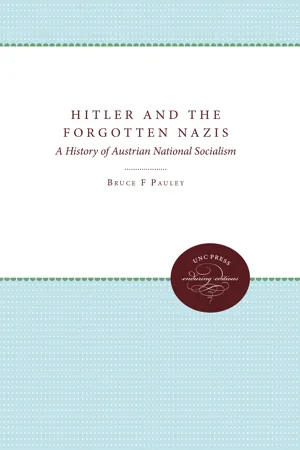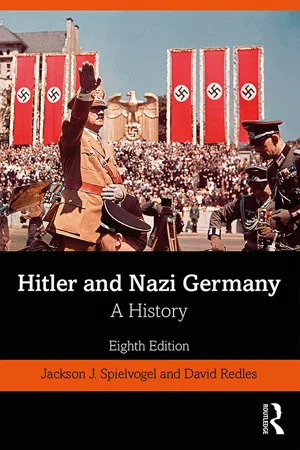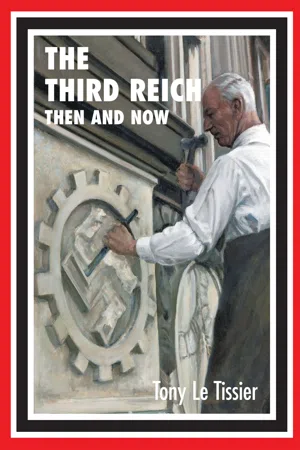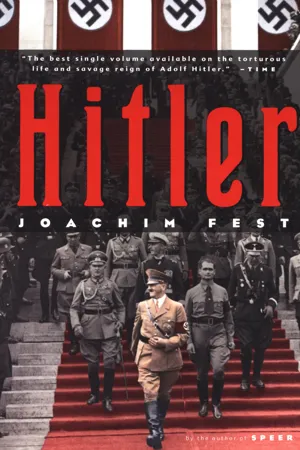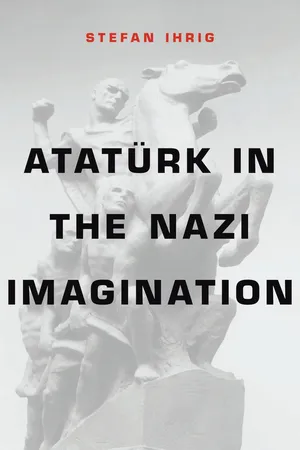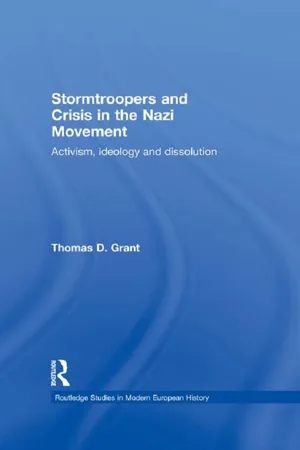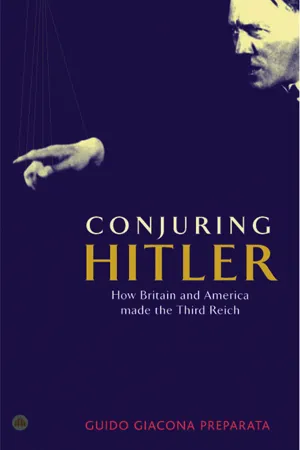History
Munich Putsch
The Munich Putsch, also known as the Beer Hall Putsch, was a failed coup attempt by Adolf Hitler and the Nazi Party in 1923. The event took place in Munich, Germany, and aimed to overthrow the Weimar Republic. The Putsch was quickly suppressed, leading to Hitler's arrest and imprisonment, but it helped raise the profile of the Nazi Party in Germany.
Written by Perlego with AI-assistance
Related key terms
1 of 5
12 Key excerpts on "Munich Putsch"
- eBook - ePub
- Alice-Catherine Carls, Stephen D. Carls(Authors)
- 2017(Publication Date)
- Routledge(Publisher)
Völkischer Beobachter ; it formed a part of the party’s official public look. In the chaotic months of 1923, the number of people who joined the party rose dramatically, reaching 20,000 members.Hitler attempted a coup, known as the “Beer Hall Putsch,” against the regional government in Munich on November 8–9, 1923. Hitler and members of the SA descended on a Munich beer hall where right-wing nationalists and Bavarian separatists were meeting. After firing a revolver shot into the ceiling, he jumped on a chair and screamed: “The national revolution has begun.”2 The next day, Hitler marched into the city with General Erich Ludendorff at his side. The marchers soon ran into a cordon of state police, which dispersed the crowds, killed 16 of the demonstrators, and sent Hitler fleeing the scene, only to be captured later. Ludendorff was arrested, tried, and acquitted. Hitler was found guilty of treason and received a five-year prison sentence, although he was released after just a few months of incarceration. While the Putsch failed owing to poor planning and miscalculations, the episode brought national attention to the Nazis for the first time. Hitler took full advantage of the trial to disseminate his ideas, scoring a propaganda victory.While in prison, Hitler wrote his seminal work Mein Kampf in which he denounced the Treaty of Versailles, argued for a superior Aryan race that included the German people, spewed out hatred for the Communists, and denounced the Jews. It was also then that he decided his party would have to play by the electoral rules of the Weimar system to obtain power. During his imprisonment, he commented to a friend:When I resume work, it will be necessary to pursue a new policy. Instead of working to achieve power by an armed coup, we shall have to hold our noses and enter the Reichstag against the Catholic and Marxist deputies. If outvoting them takes longer than outshooting them, at least the result will be guaranteed by their own constitution. Any lawful process is slow … Sooner or later we shall have a majority – and after that, Germany.3 - eBook - PDF
- Harold J. Gordon(Author)
- 2015(Publication Date)
- Princeton University Press(Publisher)
They be- lieve in what Goebbels was later to call the "triumph of the will," and surprisingly often the will does triumph, at least for a time. Certainly in this period of crisis it triumphed briefly in Hitler and in the councils of the Kampfbund, just as it was later to triumph first in Germany and then in much of Europe. Even as Bomhard wrote his complacent words, the planning for a Putsch was underway. 6 3 B, iv, BuR, Bd. 34, Bomhard Lagebericht, 26.10.1923. 238 40. THE COMING OF THE PUTSCH I. The Economic Pressures One of the most important factors in bringing on the Beer Hall Putsch was the disastrous economic situation that developed in Germany in the fall of 1923. The German economy had never re- covered from World War I and from the losses and dislocations caused by the Treaty of Versailles. Massive unemployment, re- duced resources, reduced foreign trade, tremendous internal war debts (although these had already been partly repudiated), repara- tions, and extremely heavy social disbursements had proven more than the postwar German economy was able to bear without re- adjustment and sacrifices. The result was that the economy was al- ready staggering drunkenly by the end of 1922. The additional cost burden of the passive resistance policy in the Ruhr was apparently the last straw and the economy broke down. A racing inflation of disastrous scope ensued. Unfortunately, the official reaction in both the Reich and Ba- varia was neither determined nor informed. By the middle of the year, drastic action would have been needed to prevent disaster, if in fact this end could still have been achieved. In September the federal finance minister, Dr. Rudolf Hilferding 1 stated succinctly: "One must clearly recognize that in the immediate future it will not be possible to cover the expenses of the Reich by income or credits. As a result one must reckon on a certain further development of the inflation under all circumstances. - eBook - ePub
Hitler and the Forgotten Nazis
A History of Austrian National Socialism
- Bruce F. Pauley(Author)
- 2017(Publication Date)
- The University of North Carolina Press(Publisher)
14 Some of it was directed against public buildings, barracks, prisons, and other government buildings as well as against judges, police officials, and politicians. Most explosions, however, occurred near tourist areas, waterworks, and power plants.It is impossible to say who was responsible for this complete collapse of the “evolutionary” policy initiated in March. As the leader of the Austrian party, however, it was Theo Habicht who bore the ultimate obligation to control these activities. The consequences of the party’s reckless defiance of international law were the diplomatic isolation of Germany and the near destruction of the party itself.The climax of the new wave of terror came early in the afternoon of 25 July when 154 members of the Viennese SS Standarte Eighty-nine, disguised in uniforms of the Austrian army, broke into the federal chancellery on the Ballhausplatz in Vienna and mortally wounded Engelbert Dollfuss. This act was just the beginning of the notorious July Putsch, which ended three days later after 153 Nazis had been killed in battle (or later executed) and thousands more had fled to Germany and Yugoslavia.The story of the Putsch, which has been told and retold in almost excruciating detail, need not be repeated here. Still of interest, however, is what induced the Austrian Nazis to take this desperate gamble, why the action misfired, and what impact its failure had on the subsequent history of the illegal party.The idea of a Putsch was an old one. The first rumors of a plot to overthrow the government reached the German Legation in Vienna on 26 July 1933, only five weeks after the party had been outlawed. This plan, to be carried out in September, was never implemented. The SA also began to work on Putsch plans during the summer, which led to conversations in October between Ernst Röhm, Hermann Reschny (the leader of the Austrian SA), Habicht, and Proksch. At a meeting in Passau the conspirators agreed that the Putsch should take place on 9 November (the tenth anniversary of the Beer Hall Putsch). It was supposed to begin in the Nazi stronghold of Carinthia and lead to a nationwide strike. A lack of weapons in Carinthia, however, prevented the execution of this plan.15 - eBook - ePub
Hitler and Nazi Germany
A History
- Jackson J. Spielvogel, David Redles(Authors)
- 2020(Publication Date)
- Routledge(Publisher)
3 The Growth and Victory of Nazism, 1924–1934 The Beer Hall Putsch and Hitler’s subsequent imprisonment proved a significant turning point in his career. Hitler saw clearly the need for a change of tactics. The Nazis could not achieve power by a frontal assault on the Weimar Republic but would have to work within constitutional or legal means. This meant the creation of a mass political party that would actively compete for votes with the other political parties in Weimar Germany. Hitler, having regained faith in himself and ever the opportunist, guided the Nazi Party through this transformation. New Beginnings: The Rebuilding of the Nazi Party, 1924–1929 Hitler was sentenced to a five-year term in Landsberg prison, 50 miles west of Munich. He was treated like a distinguished guest and established a pleasant daily routine. Hitler now had time to reflect on the lessons of the Beer Hall Putsch. Disillusioned by the weakness of the Bavarian authorities, he became convinced that he alone would have to lead the national revolution and that it no longer sufficed to play the role of “drummer” for nationalist forces in Bavaria. The German army would have to be courted more carefully and subtly. Its opposition had meant certain failure for the putsch. If the Nazis had any hope of gaining power, it would have to be with the support or, at least, the neutrality of the army. Most important, Hitler perceived that he and the Nazis would have to seek power by legal or pseudolegal means, within the framework of the Weimar political system. Once in power, the Nazis could dismantle the republic by using the agencies of the state itself. Mein Kampf The most immediate and tangible result of Hitler’s stay in prison was the first volume of Mein Kampf (My Struggle) (the second volume was completed in 1926). Rudolf Hess, one of Hitler’s most devoted followers, had voluntarily joined his leader in prison and served as his secretary - eBook - PDF
The Third Reich
Then and Now
- Tony Le Tissier(Author)
- 2004(Publication Date)
- After the Battle(Publisher)
Hitler advanced escorted by two bodyguards with their pistols point-ing at the ceiling and people stood on their chairs to try and see what was hap-pening. Hitler stood on a chair and fired a shot into the ceiling to attract attention in the uproar. He announced that the national revolution had broken out and that 600 armed men were surrounding the hall. If there was trouble, they would bring a machine gun into the gallery. The Bavarian Government was deposed and a provisional Reich Government was to be formed. He then asked von Kahr, von Seisser and von Lossow to accompany him into the adjoining room, guaranteeing their safety. Göring managed to calm down some of the bedlam in the hall by asking the crowd to sit down and enjoy their beer. Meanwhile Hitler was addressing the triumvirate, excitedly waving his pistol around, saying that no one would leave without his permission. He declared the formation of a new Reich Government with himself as the head. Ludendorff would be in charge of the Army with von Lossow as Reichswehr Minister, Seisser Police Minister, and von Kahr head of Bavaria with Ernst Pöhner, a prominent Nazi and former chief of police in Munich, as Minister President with dictatorial powers. He apologised for having to force the pace, but action was needed. If things should go wrong, he had four rounds in his pistol, one each for them and one for himself. 103 Provisionally repaired, the Bürgerbräukeller was used during the war as a depot for dairy products. Munich was entered by the Americans on April 30, 1945, the building soon being looted by the hungry population. From 1945 to 1957 it was a service club for US military personnel before reverting to a public beer hall. This is how it looked when we pictured it in 1974. In September 1979 the historic beer hall was pulled down to make way for the new Munich City Hilton Hotel and the adjoining GEMA (municipal electricity company) building. - eBook - PDF
- Alan E. Steinweis, Alan E Steinweis(Authors)
- 2009(Publication Date)
- Belknap Press(Publisher)
On November 9, the entire Nazi leadership congregated in Munich to observe the anniversary of the Beer Hall Putsch of November 9, 1923. This annual commemoration consisted of a series of highly ritualized 40 kristallnacht 1938 and minutely choreographed marches and ceremonies, some of which possessed the pseudo-religious quality of a Nazi Passion Play. 12 They were designed to retrace the route of Hitler’s movements fifteen years earlier, to honor the Nazi martyrs who fell during the putsch, and to celebrate the victory of the Nazi movement over its adversaries. The symbolic core of the commemoration unfolded between noon and 2:00 pm. Hundreds of Nazi “Old Fighters” gathered at the Bürgerbräukeller, the beer hall in which the 1923 putsch attempt had begun, where they were met by Hitler. Forming a column, they marched through the swastika-draped streets of Munich. The procession made its way to the Feldherrnhalle at Odeonsplatz, following, as though it were a Nazi ver-sion of the Via Dolorosa, the same route that the martyred Nazi putsch-ists had taken in 1923. At the Feldherrnhalle the faithful were presented with the “blood flag,” which had been carried in 1923, and which now possessed the status of a sacred relic. Serving as a kind of high priest, Hitler presided over a ceremony honoring the sixteen Nazis who had been killed during the putsch. The scene then moved not far away to Königsplatz for its climax. After 1933, the Nazi Party had converted this gigantic square into the site of its national headquarters, adjacent to which it had erected two temples, in Nazi neoclassical style, containing the sarcophagi of martyrs of the movement. In a solemn ceremony be-fore thousands of uniformed Nazis standing silently in formation, these fallen Nazis were now granted a final muster. - eBook - ePub
The Undercover Nazi Hunter
Exposing Subterfuge and Unmasking Evil in Post-War Germany
- Wolfe Frank(Author)
- 2020(Publication Date)
- Frontline Books(Publisher)
2 .A putsch is a secretly plotted and suddenly executed attempt to overthrow a government. The Beer Hall Putsch, also known as the Munich Putsch was a failed coup attempt by the Nazi Party leader Adolf Hitler to seize power in Munich. Hitler was found guilty of treason and sentenced to five years imprisonment in Landsberg Prison but was released after nine months.3 .The Dachau trials, held within the former Dachau concentration camp in Bavaria, tried those war criminals caught in the United States zones of Occupied Germany and Austria and those accused of committing war crimes against American citizens and military personnel.4 .Gruess Gott is a Bavarian greeting that can range in meaning from deeply emotional to casual.5 .The Pour le Mérite is a German order of merit that was established in Prussia as a decoration for exceptional military valour equivalent to the Victoria Cross (VC). Worn on the collar its cross was sky blue in colour which gave it the nickname ‘The Blue Max’.Passage contains an image
BREAKDOWN OF GERMAN MORALS1
Hangover After Hitler Series: Published Friday 9 December 1949W HEN I WENT INTO GERMANY, there were a good many things I wanted to find out about, and most of them cost me considerable effort. Some things the Germans hated to talk about to strangers and some things they hated to talk about at all; many phases of German life never come to the surface, and it takes a good bit of hunting around to find them. But in every part of the country there was one subject that I never had to go out of my way to investigate, and that was sex. It was no trouble at all, thank you.For one thing, there are seven women to every five men in Germany and, travelling alone as I was, I had all the earmarks of a bachelor. In Germany, a bachelor is first prize. And being in this rare position, he is expected to shop around, which in this case means not only studying the products set out for his delectation, but also tasting them now and then.And the products come packaged for quick sale. The man who invented the sweeping neckline can by-pass New York and Paris and Rio, if he wants to see his invention on display. Bavaria is the area for his investigation. In Munich there were times when it appeared that the neckline had been swept away entirely and was rapidly becoming a waistline. On chilly days the girls wear sweaters, which they apparently borrow from their little sisters. ‘Why not?’ said a girl to me in a cafe in Briennerstrasse. ‘we have to show what we’re selling. What you’re looking at is our working capital’. - eBook - ePub
- Joachim Fest(Author)
- 2017(Publication Date)
- Mariner Books(Publisher)
The Putsch
And then a voice shouted, “There they come, Heil Hitler!”Eyewitness account, November 9, 1923The two days leading up to November 8 were filled with nervous activity. Everyone negotiated with everyone else, Munich reverberated with warlike preparations and rumors. The Kampfbund’s original plan called for staging a major night maneuver north of Munich on November 10; the next morning they would march into the city, still pretending to be an ordinary parade, and on reaching the center would proclaim the nationalist dictatorship, thus forcing Kahr, Lossow, and Seisser to commit themselves. While consultations were still going on, it was learned that Kahr was planning to deliver an important address on the evening of November 8 in the Bürgerbraukeller; the cabinet, Lossow, Seisser, the heads of all the government agencies, industrial leaders and directors of the patriotic organizations were invited. Fearing that Kahr might get the jump on him, Hitler revised all his plans at the last moment and decided to act the following day. The SA and the Kampfbund units were mobilized in great haste, and the stage was set.The meeting was to begin at 8:15 P.M. Dressed in a black dress suit, wearing his Iron Cross, Hitler drove to the Bürgerbraukeller. Next to him in the recently acquired red Mercedes sat Alfred Rosenberg and Ulrich Graf, as well as the unsuspecting Anton Drexler, for whom this was to be the last appearance with Hitler’s coterie. For reasons of secrecy he had been told that the group was driving out to the country for a meeting. When Hitler now revealed that he was going to strike at 8:30, Drexler replied shortly and testily that he wished Hitler luck in his undertaking but he himself would have nothing to do with it.A large crowd was milling about in front of the Bürgerbraukeller, so large that Hitler feared he might be unable to storm the meeting, which was already under way. Hitler summarily ordered the police officer on duty to clear the area. Kahr was well into his speech, evoking the image of the “new man” as the “moral justification for dictatorship,” when Hitler appeared in the door of the beer hall. According to eyewitness accounts, he was extremely agitated. In a moment some trucks full of SA men roared up, and the troops swarmed out to cordon off the building in good warlike style. With his typical love for the theatrical gesture, Hitler held up a beer stein, and as a heavy machine gun made its appearance at his side, he took a dramatic swallow, then dashed the stein to the floor, and with a pistol in his raised hand stormed into the middle of the hall at the head of an armed squad. As steins crashed onto the floor and chairs toppled, Hitler leaped up on a table, fired his famous shot into the ceiling to catch the crowd’s attention, and forced his way through the dumfounded throng to the podium. “The national revolution has begun,” he cried. “The hall is surrounded by 600 heavily armed men. No one may leave the premises. Unless quiet is restored immediately, I shall have a machine gun placed in the gallery. The Bavarian government and the national government have been overthrown, and a provisional national government is being formed. The barracks of the Reichswehr and the state police have been occupied; the Reichswehr and the state police are already approaching under the swastika flag.” He then told Kahr, Lossow, and Seisser “in a harsh tone of command,” the account goes, to follow him into the next room. The crowd inside the hall began calming down, only spluttering now and then, “Playacting!” or “South America!” The SA, however, suppressed such remarks in its own special fashion. Meanwhile, Hitler, in a bizarre scene, attempted to win the reluctant representatives of state power over to his side. - eBook - PDF
- Stefan Ihrig(Author)
- 2014(Publication Date)
- Belknap Press(Publisher)
I t was an unsuccessful endeavor and failed within five days. “To stage a putsch without a cabinet ready at hand was just childish,” remarked a commentator in Berlin just after the failure of the Kapp Putsch in 1920. This commentator was the former grand vizier of the Ot-toman Empire Talât Pasha. Ernst Troeltsch, theologian and politi-cian, was impressed by the clarity of the advice of this Turkish “mas-ter of revolution.” 1 Talât Pasha might have been right about the dilettantism of the failed Kapp Putsch, but he was not the Turkish voice the German far right was eager to hear at this time. People had already turned to another Turk for solutions, and also away from Ber-lin, which had failed to provide remedies, to Munich, the hub of the völkisch right. And there, within three years, the young Weimar Re-public would be challenged by yet another putsch from the right— the Hitler Putsch. This attempted seizure of power, contrary to cur-rent wisdom in historiography, was inspired much more by Mustafa Kemal and the events in Anatolia than by the example of Mussolini’s “March on Rome.” Mussolini has often been seen as the Nazis’ prime role model. This view was partly influenced by Hermann Esser’s iconic quote about Hitler being the “German Mussolini.” 2 But there has been little re-search into how the Italian or the now-forgotten Turkish role mod-2 “Ankara in Munich” The Hitler Putsch and Turkey “Ankara in Munich” 69 els exerted their influence. 3 Usually the history of both movements, Italian Fascism and Kemalism, if the latter is mentioned at all, is merely recaptured in a sentence, in passing. The assumed role-model function of Mussolini, mainly deduced from the later significance of Fascist Italy, has led many authors to overestimate Italy and the March on Rome, and even to infer that the Hitler Putsch was ex-plicitly intended to copy the March on Rome. - eBook - ePub
Stormtroopers and Crisis in the Nazi Movement
Activism, Ideology and Dissolution
- Thomas D. Grant(Author)
- 2004(Publication Date)
- Routledge(Publisher)
3 The only remaining means for the Nazis to seize power — the “third way” — was to enter a national cabinet on terms set by the governing elite, and this Hitler had twice refused to do — once after the July 31 election and again after the November 6 election. Repeatedly denied its objective, the Hitler movement finally seemed to have seen its drive for power stall. That this impasse for the Nazis was also the twilight of the Republic would be evident in hindsight alone.The following chapters aim to depict the general state of crisis within Nazism on the eve of Hitler's seizure of power, and, in particular, the troubles which plagued one part of the movement, the SA. It has been noted well that National Socialism on the eve of the Machtergreifung faced an internal crisis. What may not be so clear from the more general literature on the subject is that Nazism by that time in fact came to be dominated by crisis. This book adds to the view a focused assessment of the final months of the Republic, with special reference to three interrelated problems in particular that beset the Nazis: distraction of stormtrooper energies away from the Nazi political project; contradictions between professed ideology and Party conduct; and a decay and dissolution of the movement's activist constituency.This study draws on observations made both by Nazis and by their non-Nazi contemporaries. SA Supreme Command and the NSDAP political offices ordered SA leaders to prepare morale reports in September 1932. A set of these survived the Third Reich and will be referred to throughout the following chapters.4 In the reports (Stimmungsberichte ), the SA respondents presented an overview of SA morale, attitude, and activity on the eve of the Machtergreifung . Conveying an impression of the actual state of the SA, these reports are just as valuable in another respect: they informed the perceptions of the leaders of the Nazi movement and thus tell us what the Nazi leaders knew about their own organization. To obtain a complete picture of the context of the seizure of power, the perceptions of the principal actors in that context must be described and understood. The morale reports, valuable in providing a portrait of things as they were, are equally valuable in illustrating how things were perceived (Figure 1 - eBook - PDF
Conjuring Hitler
How Britain and America Made the Third Reich
- Guido Giacomo Preparata(Author)
- 2005(Publication Date)
- Pluto Press(Publisher)
3 The Meltdown and the Geopolitical Correctness of Mein Kampf Between the Kapp and the Beerhall Putsch, 1920–23 Barbarians since time immemorial, rendered ever more barbarous by diligence, science and even by religion…This is a harsh thing to say, yet I must, because it is true: I cannot imagine a people that is more torn than the Germans. You see craftsmen, but no human beings, thinkers, but no human beings, priests, but no human beings, masters and servants, young ones and settled families but no human beings – is this not like a battlefield, where hands, arms and limbs lie scattered helter-skelter, while gushes of lifeblood sink through the sand?… Friedrich Hölderlin, Hyperion 1 Yet I long for Kaukasos!…I was told long ago that our forefathers, the German tribe quietly coasted down the Danube of a summer’s day and reached the Black Sea, meeting with the children of the Sun seeking shade…For a while they stood in silence, then offered their hands in friendship. Friedrich Hölderlin, The Migration 2 Erzberger: one man alone against the inflation After the Treaty of Versailles was ratified, the incubation of Nazism began. Underneath the republican pretense of Weimar, the reactionary Right slowly reorganized itself: it spoke through the Nationalist press, and intimidated the Leftist opposition by unleashing against it the rage of jobless hooligans, whom the Conservatives shielded and patronized. Mistaking the Weimar regime, which was but the sham government imposed by the Allies, for a workable political experiment, the Catholic politician Matthias Erzberger treated the phoney Republic as a frail outfit which he trusted he might heal, without suspecting the perilous nature of the task. As he proceeded in the guise of Finance Minister to tax the elite heavily (1919), hoping thereby 89 - eBook - ePub
Hitler's Violent Youth
How Trench Warfare and Street Fighting Moulded Hitler
- Bob Carruthers(Author)
- 2019(Publication Date)
- Pen & Sword Military(Publisher)
troops suddenly surrounded the Bürgerbraukeller. Hitler at the head of a phalanx of around 20 of his closest associates pushed forward into the hall. At Hitler’s shoulder marched Hermann Göring, Alfred Rosenberg, Rudolf Hess, Ernst Hanfstaengl, Ulrich Graf, Johann Aigner, Adolf Lenk, Max Amann, Scheubner-Richter, Wilhelm Adam. Not present were Julius Streicher and Ernst Röhm. Ernst Röhm was waiting with his Reichskriegsflagge Freikorps in the Löwenbräukeller, another beer hall, and he was tasked with the objective of seizing key buildings throughout the city in order to bring the police and the army into line with the putschists. At the same time, other co-conspirators under Gerhard Rossbach were to mobilise the students of a nearby Officers Infantry school to seize other objectives. Communications were difficult and Hitler was receiving only sketchy reports of what was happening elsewhere. Röhm had been given a key role to play but on the night his objectives were too numerous and widespread, and it was his bodged efforts which would lead to the putsch unravelling over the course of the next 24 hours. Back in the Bürgerbrauhaus, in order to ensure that the assembled hall knew Hitler meant business, a detachment of his SA men mounted a machine gun in the entrance and trained the weapon on the crowd. To complete the impression Hitler jumped up on a table and, with a melodramatic flourish, fired a revolver shot into the ceiling. Naturally this commotion caused Kahr to paused in mid speech. As the audience strained to view the cause of the disturbance Hitler made his way to the platform. A police major tried to stop him, but Hitler was not found wanting in his moment of action. He was resolutely focused on his goal and he menacingly pointed the pistol at the policeman who seeing the murderous intent in Hitler’s eyes sensibly stepped back and allowed Hitler to push on towards the stage
Index pages curate the most relevant extracts from our library of academic textbooks. They’ve been created using an in-house natural language model (NLM), each adding context and meaning to key research topics.


